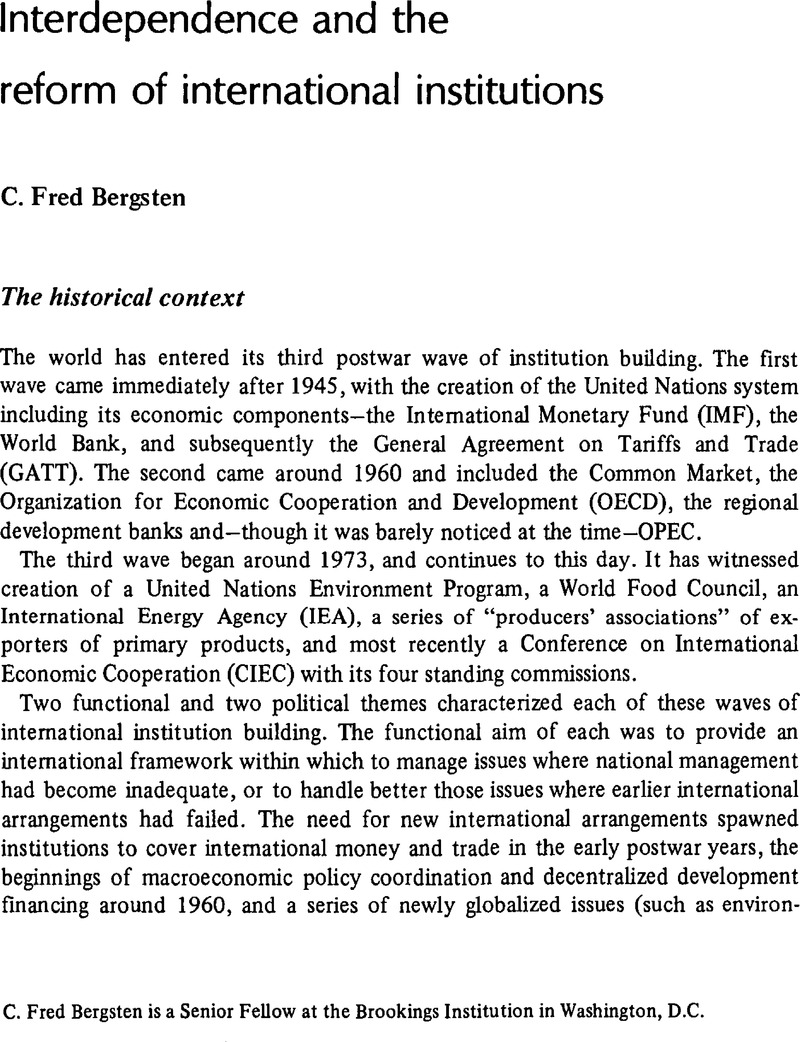Article contents
Interdependence and the reform of international institutions
Published online by Cambridge University Press: 22 May 2009
Abstract

- Type
- Symposium: New Directions for International Institutions
- Information
- Copyright
- Copyright © The IO Foundation 1976
References
1 The several criteria against which to judge international economic arrangements, including the several trade-offs between economic and political objectives, are analyzed in Bergsten, C. Fred, Keohane, Robert O. and Nye, Joseph S., “International Economics and International Politics: A Framework for Analysis” in Bergsten, Krause, Lawrence B. (eds.), World Politics and International Economics (Washington: The Brookings Institution, 1975), pp. 22–36Google Scholar.
2 “Leadership” and “management” can of course be exercised through market forces as well as overt governmental action. But governmental action will always be necessary to establish a market-oriented system in the first place, hold at bay those forces which perennially seek to reduce the scope for market forces, and make the market work better by countervailing distortions to it (such as the monopoly power of some individual firms). A recent example is the active US lead in maintaining maximum scope for market forces to determine international exchange rates.
3 This point is stressed by Kindleberger, Charles P., most recently in The World in Depression 1929–1939 (London: Allen Lane The Penguin Press, 1973)Google Scholar.
4 The useful distinction between structure and process levels is developed in Keohane, Robert O. and Nye, Joseph S., “World Politics and the International Economic System,” in Bergsten, C. Fred, The Future of the International Economic Order: An Agenda for Research (Lexington, Mass.: D.C. Heath and Co., 1973), esp. pp. 117–26Google Scholar.
5 This was characterized as a “two-track” (security and economic) or “multi-track” (security, monetary, trade, etc.) system in Cooper, Richard N., “Trade Policy is Foreign Policy,” Foreign Policy 9 (Winter 1972–1973)Google Scholar.
6 These proposals are detailed in Bergsten, C. Fred, Horst, Thomas O., and Moran, Theodore H., American Multinationals and American Interests (Washington: The Brookings Institution, forthcoming, 1976)Google Scholar. The need for institutional reform is featured in Bergsten, C. Fred, “Coming Investment Wars?” Foreign Affairs (10 1974)Google Scholar.
7 See also the views expressed by Krause, Lawrence B. and Nye, Joseph S., “Reflections on the Economics and Politics of International Economic Organization,” in Bergsten, C. Fred and Krause, Lawrence B. (eds.), World Politics and International Economics (Washington: The Brookings Institution, 1975)Google Scholar.
8 For detailed proposals see Bergsten, C. Fred, Completing the GATT: Toward New International Rules to Govern Export Controls (Washington: British-North American Committee, 10 1974)Google Scholar.
9 Detailed proposals are in Bergsten, C. Fred, The Dilemmas of the Dollar: The Economics and Politics of United States International Monetary Policy (New York: New York University Press, for the Council on Foreign Relations, 1976)Google Scholar. A shorter analysis of the liquidity problem is in Bergsten, C. Fred, “New Urgency for Monetary Reform,” Foreign Policy 19 (Summer 1975)Google Scholar.
10 One set of proposals can be found in Bergsten, C. Fred, “The Response to the Third World,” Foreign Policy 17 (Winter 1974–1975)Google Scholar. A series of official US proposals were announced at the Seventh Special Session of the UN General Assembly on September 1, 1975.
11 On this issue see Keohane, Robert O. and Nye, Joseph S., “Transgovernmental Relations and International Organization,” World Politics (10 1974)Google Scholar.
12 See “The United States and Germany: The Imperative of Economic Bigemony,” in Toward a New International Economic Order: Selected Papers of C. Fred Bergsten, 1972–1974 (Lexington, Mass.: D.C. Heath and Co., 1975)Google Scholar.
13 See “U.S. Foreign Economic Policy and Europe: The Ascendance of Germany and the Stagnation of the Common Market” in work cited above.
14 Katzenstein, Peter J., “International interdependence: Some Long-Term Trends and Recent Changes,” International Organization (Autumn 1975)Google Scholar.
- 14
- Cited by


